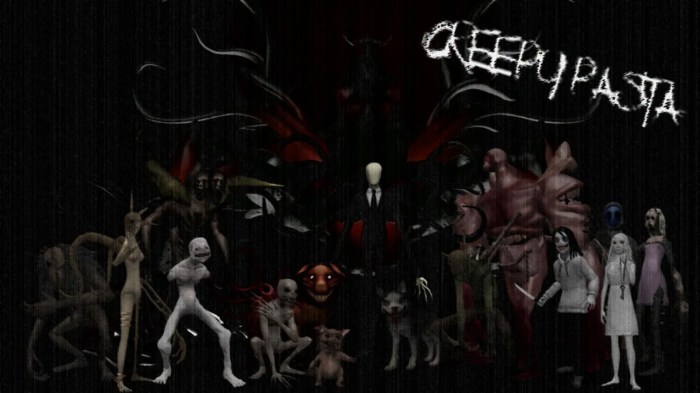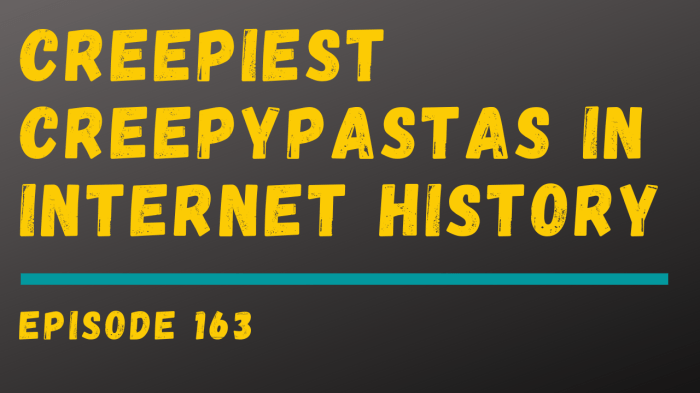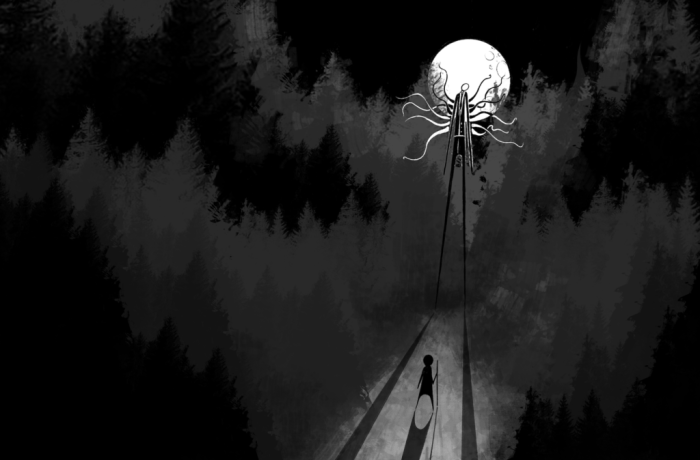Origins of creepypasta internet folklore begins with the haunting whispers of ancient folklore, evolving into the digital age. From whispered tales around campfires to the vast, interconnected web, the chilling narratives have adapted and mutated, echoing through online forums and social media. This exploration delves into the eerie origins, examining the elements that made these stories so captivating and enduring.
The early influences, from urban legends to ghost stories, set the stage for creepypasta’s rise. The internet, with its unique features, provided a new platform for these tales to spread, evolve, and reach a global audience. The creative process behind crafting and sharing these stories is also examined, revealing the techniques employed to generate suspense and fear, along with the humor and irony that often intertwine with the macabre.
Early Influences

The digital realm, with its relentless spread of information, is not a vacuum. It draws sustenance from the rich tapestry of human storytelling, a tapestry woven over millennia. Creepypasta, in its unique blend of fear and fascination, owes a significant debt to these earlier forms of oral and written folklore. The chilling whispers of the past echo through the internet, carrying with them the same primal anxieties and captivating narratives.
The origins of creepypasta are deeply rooted in pre-internet folklore traditions. Urban legends, ghost stories, and tales of the macabre have been passed down through generations, each iteration adding a layer of embellishment and fear. These narratives often served a purpose beyond mere entertainment; they instilled caution, reinforced social norms, and offered a glimpse into the unknown. These stories evolved and adapted to different cultural contexts and societal concerns, evolving with the times and adapting to new audiences.
Pre-Internet Folklore Traditions
Early forms of folklore often relied on vivid imagery and compelling narratives to transmit knowledge and values. Ghost stories, for instance, often warned against transgressions, while urban legends frequently depicted the consequences of foolish actions or social deviance. The oral tradition played a crucial role in preserving these narratives, ensuring their adaptation and evolution over time. These stories were shaped by the cultural values and anxieties of the time, reflecting the fears and fascinations of the societies that told them.
Elements of Urban Legends and Ghost Stories
Urban legends, characterized by their focus on the plausible but improbable, often featured mundane settings and situations, but with a twist that added an element of dread. These stories typically served to caution against dangerous behaviors or warned against social isolation. Ghost stories, conversely, often explored the supernatural, drawing on the unknown and the unexplained. Both genres relied on exaggeration, embellishment, and repetition to build suspense and transmit their message. These elements found their way into the early forms of creepypasta, further amplifying the fear and intrigue.
Evolution of Storytelling Techniques
The storytelling techniques employed in pre-internet folklore often involved repetition, exaggeration, and a sense of communal participation. Stories were frequently told in a manner that engaged the audience, creating a sense of shared experience and building upon the original narratives. This method, along with the human tendency to embellish and amplify stories over time, is strikingly similar to the way creepypasta narratives develop online. The act of sharing and reinterpreting played a key role in the perpetuation and transformation of these stories.
Comparison of Themes and Motifs
Traditional folklore often revolved around themes of death, the supernatural, and the unknown. These themes resonated deeply with human anxieties about mortality, the unexplained, and the dangers of the world around us. Similarly, early creepypasta narratives explored similar themes, utilizing the internet as a new platform to share and amplify these fears. Both types of narratives used cautionary tales to caution against certain behaviors and instill a sense of fear.
Table: Evolution of Folklore Themes
| Theme | Description | Era |
|---|---|---|
| Death and Mortality | Exploration of death, fear of the unknown, and anxieties about the afterlife. | Pre-internet |
| The Supernatural | Stories involving ghosts, spirits, and other supernatural entities. | Pre-internet |
| The Unknown | Tales about mysteries, secrets, and the unexplained aspects of the world. | Pre-internet |
| Cautionary Tales | Stories designed to warn against certain behaviors or dangers. | Pre-internet and Early Internet |
| The Supernatural in Modern Contexts | Supernatural elements presented in modern settings and scenarios. | Early Internet |
The Rise of the Internet as a Storytelling Platform

The internet, a sprawling digital tapestry woven from interconnected threads, transformed storytelling in profound ways. No longer confined to print, radio, or television, narratives found a new, dynamic home in cyberspace. This digital frontier, with its unique characteristics, became a fertile ground for the cultivation of a peculiar genre – creepypasta.
The internet’s decentralized nature, its vast network of interconnected forums and communities, and its ability to rapidly disseminate information provided a perfect breeding ground for the propagation of these unsettling tales. The anonymity afforded by the digital realm, coupled with the desire for shared experiences and the thrill of the unknown, contributed significantly to the rise of creepypasta.
Online Forums and Message Boards
The emergence of online forums and message boards in the late 1990s and early 2000s created spaces where individuals could connect, share, and discuss. These digital gathering places were ideal environments for the development and spread of narratives. Users could engage in collaborative storytelling, crafting tales that built upon each other, and the anonymity allowed for a certain level of fearlessness in the expression of ideas, contributing to the genre’s unique atmosphere.
Early Social Media’s Influence
Early social media platforms, like the predecessors of today’s platforms, acted as extensions of these forums. They provided a different avenue for sharing and engaging with narratives. The ease of posting and the rapid dissemination of information through social media accelerated the spread of creepypasta, enabling the tales to reach a broader audience and encouraging further iterations and variations.
Key Online Communities
Numerous online communities played pivotal roles in shaping the evolution of creepypasta. Early internet forums dedicated to horror, urban legends, and the macabre fostered a culture of sharing and developing these tales. These spaces provided a sense of community for individuals fascinated by the unsettling and the unusual.
Methods of Spread and Factors Driving Popularity
The methods employed for spreading creepypasta were diverse and often relied on the unique characteristics of the internet. Stories were posted on forums, copied to message boards, and shared via email chains, further amplifying their reach. The stories’ ability to tap into human anxieties, their often unsettling or macabre nature, and their capacity to generate discussion and speculation were key factors in their growing popularity. These elements combined to create a self-reinforcing cycle of spreading and fascination.
Table: Key Online Platforms and their Contributions
| Platform | Function | Impact |
|---|---|---|
| Early Internet Forums (e.g., Usenet, early bulletin board systems) | Provided spaces for discussion, sharing, and development of narratives. | Served as a breeding ground for collaborative storytelling, fostering a sense of community among users. |
| Message Boards (e.g., early forum websites) | Facilitated the exchange of information and stories. | Contributed to the rapid spread of narratives, as stories could be easily copied and circulated. |
| Early Social Media Platforms | Provided a platform for sharing and disseminating stories to a wider audience. | Accelerated the spread of creepypasta, allowing tales to reach a larger and more dispersed audience. |
The Creation and Dissemination of Creepypasta

The digital ether, once a realm of simple text-based communication, became a fertile ground for a new breed of folklore. Creepypasta, these unsettling narratives, began to take root in online forums, chatrooms, and message boards, nurtured by a unique blend of storytelling techniques and the immediacy of the internet. This evolution saw the emergence of a distinct style, a chillingly effective combination of fear, humor, and the ever-present allure of the unknown.
The creation and sharing of creepypasta were profoundly influenced by the interactive nature of the internet. Individuals could craft narratives, often in response to existing ones, building upon and twisting them in ways that amplified their unsettling appeal. This dynamic exchange, this shared crafting of the macabre, gave rise to a distinctive ecosystem of fear.
Crafting Creepypasta Narratives
The crafting of effective creepypasta involves a deliberate use of techniques designed to heighten suspense and fear. Masterful creators often employ a specific tone, employing fragmented sentences, abrupt shifts in perspective, and vivid descriptions of unsettling imagery. This deliberate style often leaves the reader with a lingering sense of unease and dread, rather than outright terror. Suspense is built through gradual revelations, leaving the reader wanting more.
The Role of Humor, Satire, and Irony
Humor, satire, and irony are not absent from the creepypasta landscape, playing a surprisingly crucial role in some narratives. Irony can subtly introduce elements of the macabre, creating a sense of dread mixed with dark humor. Satirical elements can target societal anxieties or specific online communities, imbuing the narrative with a layer of social commentary. These elements, while unexpected, often contribute to the overall appeal and memorability of a piece, making it stick in the reader’s mind. An example might be a narrative that parodies a horror movie trope but subtly incorporates terrifying details, creating an ironic horror that unsettles the reader.
Characteristics of Popular Creepypasta
Popular creepypasta often shares a set of recognizable characteristics. They often center around urban legends, myths, or unsettling personal experiences, amplified by the internet’s tendency to magnify the unusual. They are often short, concise, and easy to share, facilitating rapid dissemination through the online community. The compelling nature of the narratives, the emotional resonance with the reader, and the unique voice of the storyteller are often key ingredients in the success of a piece. A strong emotional hook, whether fear, curiosity, or even a hint of macabre humor, helps them resonate with a large audience.
Different Styles of Creepypasta
Creepypasta exhibits a wide range of styles and tones. Some focus on the supernatural, while others explore psychological horror, delving into the darkest corners of the human psyche. Some are straightforward tales of terror, while others employ dark humor and irony to create a uniquely unsettling atmosphere. This variety keeps the genre engaging and fresh, appealing to a broad spectrum of readers. The diversity in narratives and tones allows the creators to tap into different aspects of the human experience and explore various facets of the macabre.
Key Elements of a Successful Creepypasta
| Element | Description | Example |
|---|---|---|
| Premise | The core concept or idea driving the narrative. | A haunting experience in a seemingly ordinary place. |
| Tone | The overall mood and atmosphere of the story. | A chilling, suspenseful tone, interspersed with dark humor. |
| Suspense | Techniques used to build anticipation and fear. | Gradual revelations, unexpected twists, and vivid descriptions. |
| Imagery | Sensory details that create a strong emotional response. | A vividly described, disturbing scene. |
| Conciseness | The ability to deliver a powerful message in a short format. | A compact narrative that still conveys a profound sense of unease. |
The Evolution of Creepypasta Themes and Motifs
Creepypasta, born from the digital ether, isn’t static. It mirrors the anxieties and fascinations of the societies that cultivate it. From early internet fears to modern concerns, the narratives shift and evolve, mirroring the ever-changing landscape of online culture and human psychology. This transformation reveals a fascinating reflection of our collective subconscious.
The themes of creepypasta are not merely random creations but rather a potent expression of the psychological and social anxieties that resonate with individuals. They are a cultural barometer, reflecting our fears, obsessions, and desires in a uniquely digital format. The evolution of these themes offers a compelling insight into how society perceives and processes its anxieties, as well as how online storytelling can become a powerful tool for exploring and expressing them.
Recurring Themes and Motifs
Creepypasta frequently explores themes of isolation, paranoia, and the unknown. These themes often intertwine with elements of horror, mystery, and the supernatural, creating a potent blend of fear and fascination. The narratives often involve unsettling encounters with the unexpected, or the insidious corruption of the familiar. These narratives often rely on a sense of dread and suspense, rather than relying on graphic violence.
Influence of Real-World Events
The content of creepypasta is often deeply intertwined with current events and societal anxieties. For instance, the rise of online harassment and the perceived vulnerability of individuals online has led to the creation of creepypasta stories centered on cyberstalking and digital manipulation. Similarly, the increasing prevalence of social media and the anxieties surrounding digital identity have resulted in narratives about identity theft, online deception, and the potential for anonymity to mask malicious intent. The evolution of social media platforms and their influence on our interactions and communication have had a direct impact on the narratives of creepypasta.
Reflection of Contemporary Fears and Anxieties
Creepypasta frequently reflects anxieties surrounding technology, societal changes, and the human condition. The narratives often explore the fear of the unknown, the loss of control, and the potential for the digital world to amplify negative aspects of human nature. These anxieties, expressed in digital form, often revolve around the fear of losing one’s identity or the misuse of anonymity. This is evidenced by stories that explore the fear of being lost in the digital world and the potential for being manipulated or controlled by others.
Adaptation and Evolution Over Time
Creepypasta’s evolution mirrors the development of the internet itself. Early stories often focused on simple, yet unsettling narratives, often utilizing the limitations of early internet technology. As technology advanced, so too did the sophistication of the narratives. The rise of social media and online communities led to a diversification of themes and a more interactive approach to story creation and dissemination.
Table: Evolution of Key Themes in Creepypasta
| Theme | Description | Examples |
|---|---|---|
| Early Internet Fears | Stories often focused on the anxieties surrounding early internet technology, anonymity, and the unknown aspects of online interactions. | “Slender Man”, “Jeff the Killer” (early iterations) |
| Cyber-related Anxieties | Stories increasingly reflected the anxieties surrounding cyberstalking, online harassment, and the misuse of anonymity. | Stories about online predators, accounts of cyberbullying, and experiences of digital manipulation. |
| Social Media Concerns | Stories centered around the anxieties of online identity, the pressure of social media, and the potential for deception and manipulation. | Stories exploring online fame, social media drama, and the impact of online reputation. |
| Modern Societal Anxieties | Stories reflected modern societal anxieties about social isolation, political polarization, and the blurring lines between reality and the virtual world. | Stories about social unrest, conspiracy theories, and the perceived dangers of technology. |
The Impact of Creepypasta on Popular Culture

The digital realm, a breeding ground for creativity, has witnessed the rise of creepypasta, a unique form of online folklore. This genre, born from the internet’s storytelling potential, has transcended its online origins to leave an undeniable mark on contemporary media. Its influence is evident in the thematic elements, narrative structures, and even the very atmosphere of modern horror productions.
Creepypasta’s impact extends beyond mere imitation; it has injected a fresh, often unsettling energy into the landscape of popular culture, offering a new perspective on what constitutes fear and fascination in the modern era. Its influence is not merely superficial; it has profoundly shaped how we experience horror and suspense in various media.
Direct Adaptations of Creepypasta Stories
The internet’s ability to facilitate rapid dissemination has allowed certain creepypasta stories to gain significant traction, prompting adaptations into other mediums. Numerous examples exist, showcasing the direct influence of online tales on the broader entertainment landscape. One notable instance is the story “Slender Man,” which inspired a string of films and merchandise, demonstrating how a simple online narrative can capture the imagination of a wider audience and translate into popular culture products.
Influence on Contemporary Horror and Suspense Genres
Creepypasta’s influence on contemporary horror and suspense is undeniable. Its focus on unsettling psychological elements, often incorporating elements of the supernatural and the macabre, has resonated with filmmakers and game developers. The emphasis on ambiguous narratives, jump scares, and pervasive dread has become a hallmark of modern horror, drawing inspiration from the chilling tales circulating online. Furthermore, the use of interactive elements and unsettling visuals in video games often mirror the interactive nature of creepypasta’s online presentation.
The Lasting Legacy of Creepypasta
Creepypasta’s lasting legacy lies not only in its impact on contemporary media but also in its contribution to the evolution of storytelling in the digital age. It exemplifies how online communities can cultivate and disseminate narratives, pushing the boundaries of what constitutes folklore in the modern era. Its influence extends to the way we engage with narrative and experience fear, demonstrating how the internet has become a potent storytelling platform.
Comparison of Creepypasta with Other Horror Genres
| Genre | Characteristics | Similarities/Differences |
|---|---|---|
| Creepypasta | Short, often unsettling narratives, focus on psychological dread, often feature elements of the supernatural, frequently involve a sense of online community and interactive participation. | Shares elements of supernatural and psychological horror with other genres, but often relies on ambiguity and interactive elements not always present in traditional forms of horror. |
| Psychological Horror | Focuses on the anxieties and fears of the characters, delves into mental states and psychological traumas, often uses symbolism and metaphor to evoke emotional responses. | Shares emphasis on psychological dread, but creepypasta often relies on the internet’s interactive nature and online community aspect that other psychological horror may not. |
| Supernatural Horror | Involves supernatural entities, paranormal activities, and the exploration of the unknown. | Often overlaps with creepypasta, as many stories involve supernatural elements. However, creepypasta’s focus on online community and interactive elements distinguishes it. |
| Gothic Horror | Features decaying settings, dark themes, and a focus on atmosphere. | Some creepypasta stories evoke gothic elements, but the interactive nature and online origins differentiate it. |
Creepypasta and the Digital Storytelling Landscape: Origins Of Creepypasta Internet Folklore

Creepypasta, born from the digital ether, has evolved into a unique form of online storytelling, distinct from traditional narratives. Its genesis within the internet’s interactive and decentralized environment has shaped its characteristics, content, and enduring appeal. This form of digital folklore, fueled by anonymity and rapid dissemination, continues to adapt and influence the very fabric of online culture.
The internet’s role as a collaborative storytelling platform is a significant factor in creepypasta’s development. Its decentralized nature fosters rapid dissemination and creative evolution. Anonymity, a cornerstone of many creepypasta pieces, allows authors to explore darker themes without fear of personal repercussions, thus shaping a unique digital storytelling experience. This freedom from traditional constraints has contributed to its distinctive characteristics.
Anonymity and Decentralized Storytelling
Anonymity empowers creators to explore taboo subjects and develop narratives that push boundaries. The absence of accountability allows for a certain freedom in experimentation, a key driver in the rapid evolution of creepypasta. The decentralized nature of the internet further fuels this phenomenon, enabling stories to spread rapidly and mutate organically through retellings and adaptations. This creates a dynamic environment where content can quickly gain traction and be modified by numerous contributors.
Comparison with Other Online Storytelling Trends
Creepypasta, while distinct, shares common threads with other online storytelling trends. The emphasis on suspense, horror, and often, the macabre, mirrors similar elements found in other online forums and communities dedicated to speculative fiction. However, the unique combination of anonymity, rapid dissemination, and a focus on the unsettling sets creepypasta apart. It stands in contrast to the more formal and structured storytelling found in traditional literature, blogs, and even fan fiction communities. While some online communities focus on humor, romance, or fantasy, creepypasta thrives on the thrill of the unknown and the unsettling.
Future Directions and Potential Evolutions
Creepypasta’s future will likely involve further experimentation with new mediums and platforms. The rise of interactive storytelling and virtual reality could provide new avenues for developing and experiencing creepypasta. Further evolution may see the integration of interactive elements into existing creepypasta narratives, allowing users to actively shape the story’s outcome. The blending of creepypasta with other forms of digital media, like video games and music, is another probable direction.
Characteristics of Creepypasta as Digital Storytelling, Origins of creepypasta internet folklore
| Characteristic | Explanation | Example |
|---|---|---|
| Anonymity | The lack of author attribution often allows for more extreme and unsettling themes. | A story about a haunted house, with no author listed. |
| Decentralized Dissemination | Stories spread rapidly through online communities, often with modifications. | A creepypasta story about a mysterious entity that evolves with each retelling. |
| Focus on the Unsettling | The primary goal is to evoke fear, dread, and a sense of unease. | A story about a creature that stalks its victims in the shadows. |
| Rapid Evolution | Stories mutate through retellings and adaptations, leading to diverse interpretations. | A story about a ritual that changes its procedure each time it is re-enacted. |
| Interactive Potential | The digital nature allows for the incorporation of interactive elements. | A creepypasta game where player choices affect the narrative. |
Ending Remarks
In conclusion, the origins of creepypasta internet folklore reveal a fascinating interplay between traditional storytelling and the digital landscape. From ancient folklore to modern anxieties, these stories have evolved and adapted, captivating audiences across the globe. Their enduring appeal lies in their ability to reflect and interact with contemporary fears, while also showcasing the power of the internet as a platform for both chilling and engaging narratives.